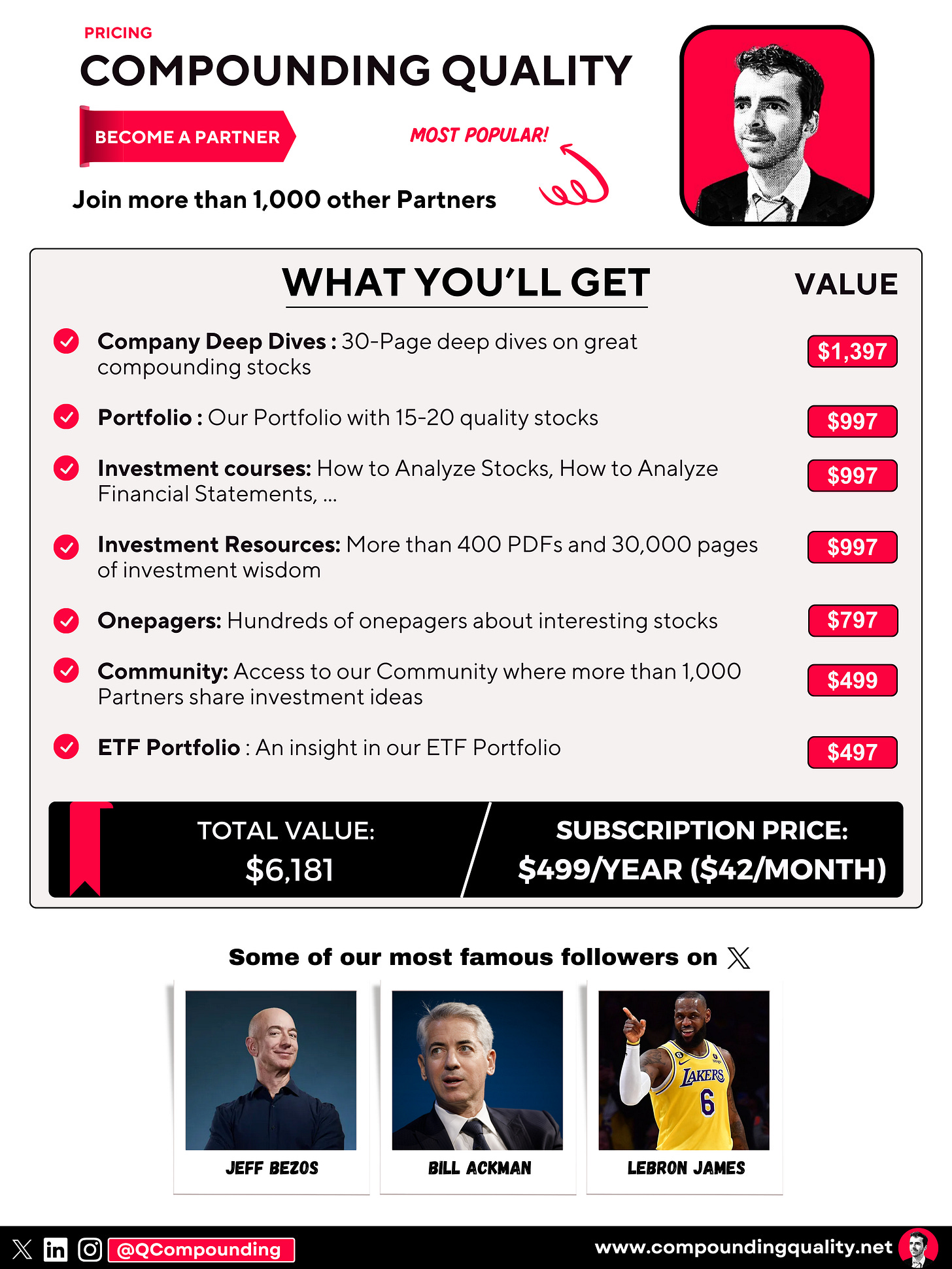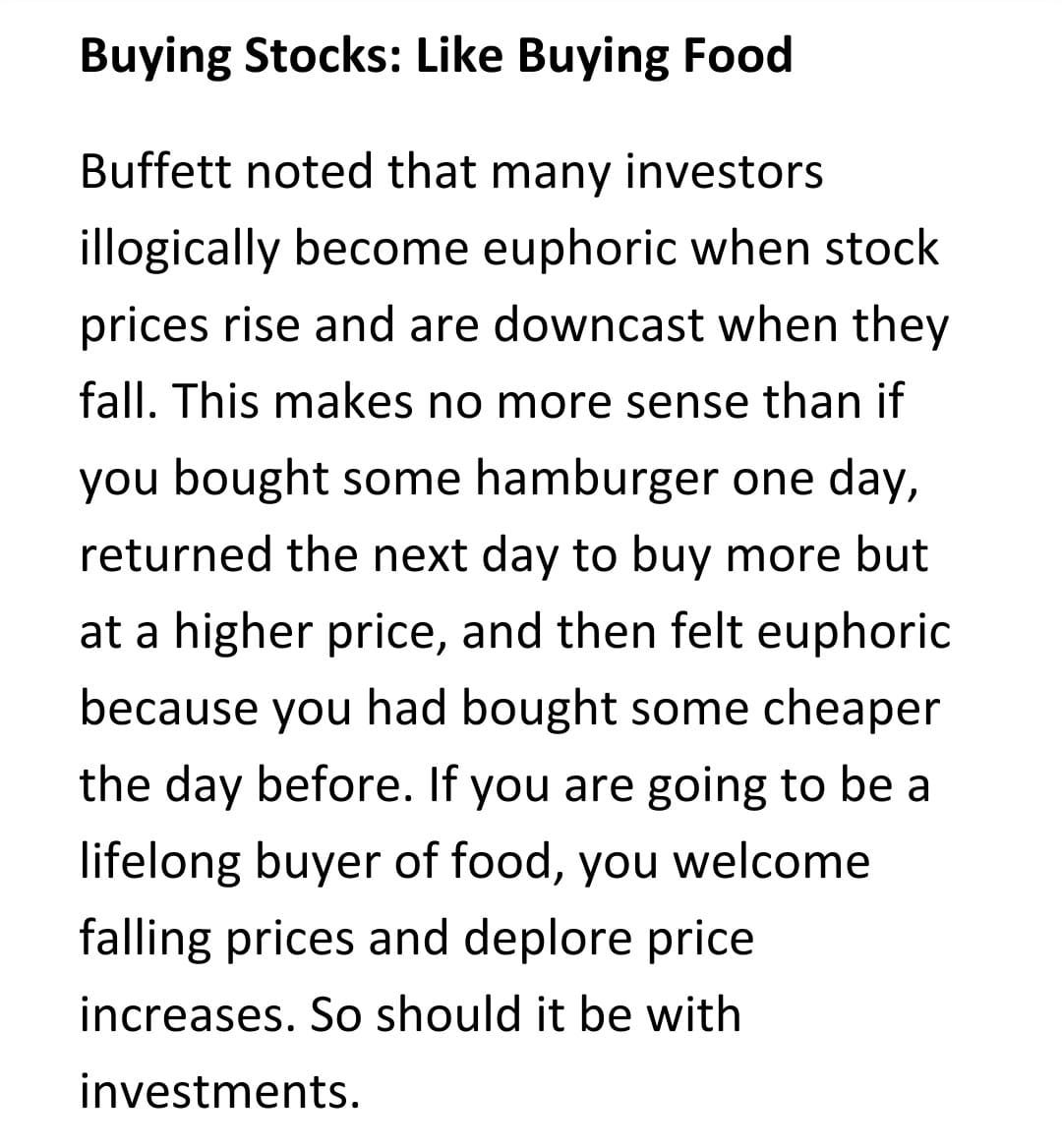FAQ
Use this FAQ to get the most out of Compounding Quality.
1. Who is Compounding Quality?
My first name is Pieter and I started writing Compounding Quality in July 2022 to help other investors along their journey.
I used to work as a Professional Investor before starting to work on Compounding Quality full-time.
Compounding Quality has a true passion for investing and helping other investors.
I aim to invest in the best companies in the world as it’s far better to buy a wonderful company at a fair price than a fair company at a wonderful price.
You can read more about Compounding Quality here.
2. How do I log into Compounding Quality?
Compounding Quality uses Substack to host its newsletter.
After you have taken a subscription, you can log in using the following steps:
On the upper right, click on ‘Sign in’ (or ‘Subscribe’ when you haven’t subscribed yet)
Login with the email address under which you have a subscription
Are you still having problems after following these steps? Take a look here.
3. How do I update my account information?
You can update your account information by following these steps:
4. Can I get a monthly subscription or a trial?
As investors, we think in the long term.
The same goes for Partners of Compounding Quality. We don’t think in quarters, we think in quarter decades.
As Tom Murphy said: “The goal is not to have the longest train but to arrive at the station first using the least fuel.”
That’s why we don’t offer monthly subscriptions or a free trial.
You can always reach out to me via pieter@compoundingquality.net.
5. What is the investment philosophy of Compounding Quality?
Quality investing is all about investing in the best companies in the world.
We use 3 steps to achieve this:
Buy wonderful companies
Led by excellent managers
Trading at fair valuation levels
In this free webinar, I outline the entire investment philosophy:
6. Is Compounding Quality something for me?
Compounding Quality is not for you if you want to:
❌ Get rich quick
❌ Blindly follow someone else’s advice
❌ Outperform the market every single year
You are in the right place if you want to:
✅ Learn and become a better investor
✅ Be assisted alongside your investment journey
✅ Outperform the market in the long term
7. Why are all paid subscribers called Partners?
That’s simple. Because we are in this together.
Having mutual respect and being honest with ourselves is very important.
Another interesting thing to know? All my investable assets are invested in the Portfolio. I eat my own cooking.
If you do well, I do well, and the other way around.
8. What do you get as a Partner?
Partners of Compounding Quality get the following:
📈 Access to my Portfolio with 100% transparency
📚 Access to my ETF Portfolio
🔎 Full investment cases about interesting companies
📊 Access to the Community
✍️ And much more!
9. How often do you publish?
As a subscriber, you’ll receive 3 articles per week.
Each Tuesday: A general article teaching you something about investing
Each Thursday: An investment case or update of the ETF Portfolio
Each Sunday: An article related to our Portfolio
10. Is there an Owner’s Manual?
Yes, there is.
The Owner’s Manual outlines our investment strategy and core beliefs.
You can read it here.
11. What is the investable universe and where can I find it?
The investable universe is a list of roughly 150 companies we quantified as Quality.
Based on this universe we are building our Portfolio.
You get access to the investable universe here.
12. Where can I find the Portfolio?
You can follow our Portfolio 24/7 with 100% transparency.
Get access here:
13. How do I know the companies you own are still worth buying?
In the Portfolio Spreadsheet, you can find a column ‘Advice’ for every company:
Strong Buy: The current stock price offers opportunities
Buy: We think the company is worth buying today
Hold: Don’t add to this position at this point
Sell: We are considering selling the stock
Furthermore, we also calculate the Fair Value of a company to determine whether the company is still undervalued or not (see question 15 in this FAQ).
14. Do you cover international stocks or only domestic ones?
Compounding Quality invests worldwide.
We are bottom-up stock pickers and we buy companies in all developed countries in the world.
15. How do you calculate the Fair Value of a company?
For every company within our Portfolio, we calculate the Fair Value (Buy-Below Price).
The Fair Value is the price at which the expected yearly return equals 10% in our Earnings Growth Model.
When the stock price is lower than the Fair Value, the stock is undervalued and it might still be worth buying the company today.
16. Where can I find the performance of the Portfolio?
The performance of the Portfolio is shown in a dedicated Excel spreadsheet.
Here’s how you can take a look at our CAGR since inception:
Click on ‘Go to spreadsheet’
Go to the tab ‘Overview transactions’
17. Where can I find the ETF Portfolio?
The ETF Portfolio can be found here:
Furthermore, there’s a dedicated page where you can find all the updates we’ve written about our ETF Portfolio. You can find this page here.
18. What is the Best Buys List?
Each month, we give an overview of our 5 most attractive stocks.
You can find the Best Buys list here:
19. Where can I get access to all investment cases?
For every company we own, there is a dedicated page.
You’ll find the full investment case of 30-40 pages as well as all articles we’ve written about the company in the past.
Here’s how you get access:
Click on the company you want to look into
Read everything we’ve written about the company in the past
20. Why do you give every company a Quality Score and how does it work?
We always use the same 15-step method to analyze a company:
Each company we look into gets a score on these 15 metrics.
Finally, the company gets a Total Quality Score on 10.
The higher the company, the more likely we want to own the stock.
21. When to buy a company?
We want to buy wonderful companies at a fair price.
While in the short term changes in valuation drive stock prices, the evolution of the intrinsic value drives stock prices in the long term.
That’s why we always look at the quality of the business first and the valuation second.
"If you bought the S&P 500 at a P/E of 5.3x in 1917, and sold it in 1999 at a P/E of 34x, your annual return would have been 11.6%. Only 2.3% p.a. came from the massive increase in P/E. The rest of your return came from the companies’ earnings and reinvestments." - Terry Smith
In general, there are 5 reasons to buy a company:
The stock is undervalued
Fundamentals are improving
The moat is strengthening
The future looks bright
Insiders are heavily buying
You can read more about reasons to buy a company here.
22. When to sell a company?
The biggest investment mistake I ever made? Selling my winners too soon.
Do you know why? A stock can only lose 100% in value but it can increase by more than 10,000%.
Just imagine that you sold Monster Beverage for $0,01 in 1987 or Apple for $0,3 in 1991.
Since their IPO, both stocks are up 72,000% and 85,000% respectively.
That’s exactly why we want to keep our winners and sell our losers as soon as possible.
Here are the most important reasons to sell a stock:
You notice you’ve made a mistake
You found a better opportunity (life is a game of opportunity costs)
The company is losing its moat
Change in management
Growth is slowing down
You need cash
You can read more about the underlying reasons here.
23. What if the stock (market) declines heavily?
We always use the Rule of Three from François Rochon:
One year out of three, the stock market will go down at least 10%
One stock out of three that we buy will be a disappointment
One year out of three, we will underperform the index
The best thing that can happen to you when you are a net buyer of stocks over the next 10 years? Declining stock prices.
Always remember that stocks are like hamburgers:
24. How do you look at the valuation of a company?
We always use 3 methods to value a company:
A comparison of the forward PE multiple with its historical average
An Earnings Growth Model
Reverse Discounted-Cash Flow
A comparison of the forward PE multiple with its historical average:
An Earnings Growth Model
A reverse DCF:
You can download the reverse DCF template here.
In the past, I’ve written two articles about valuation:
25. What are the 100 Owner-Operator Stocks?
The 100 Owner-Operator Stocks is a dedicated investable universe that consists of 100 High-Quality stocks that are led by excellent managers with skin in the game.
You can get access to this universe here.
26. How to think about FX Risks?
Some Partners are worried that Foreign exchange movements (FX movements) could hurt our returns.
When you would for example buy a company in Australian Dollars (AUD) and the stock price goes up by 8% but the AUD loses 10% in value compared to your domestic currency, you still lose 2%.
Is this something to worry about?
The short answer is no if you ask me.
Do you know why? It’s impossible to predict FX movements.
Peter Lynch once said that if you spend 13 minutes a year on economics you’ve wasted 10 minutes.
I completely agree with him.
When you buy several companies in different currencies like we do, sometimes you will win due to FX movements and sometimes you’ll lose. In the end, the losers tend to be offset by the winners on average.
That’s exactly why we just try to find good companies.
When we find a great company led by excellent managers trading at fair valuation levels, we will buy the company regardless of where it trades.
"I am constantly amazed at the number of people who talk about investment and spend most or all of their time talking about asset allocation, regional allocation, sector weightings, economic forecasts, bonds vs equities, interest rates, currencies, risk controls and never mention any need to invest in something good." - Terry Smith
27. What do you think about Portfolio Allocation?
✅ The portfolio will invest worldwide (developed countries only)
✅ We’ll own 15-20 stocks
✅ The portfolio is aiming to invest in the best companies in the world
✅ We won’t trade a lot. Activity and costs harm our results
✅ We won’t try to time the market (I’m way too dumb for that)
✅ The characteristics of companies in the portfolio:
Sustainable competitive advantage
Integer management with skin in the game
Healthy balance sheet
Low capital intensity
Good capital allocation
High profitability
Plenty of reinvestment opportunities
Trading at fair valuation levels
“It's far better to buy a wonderful company at a fair price than a fair company at a wonderful price.” - Warren Buffett.
28. Can I gift a subscription to someone else?
Yes, you can by following these steps.
29. Why is the Community so valuable and how do I join?
In the Community, all Partners of Compounding Quality gather together.
We discuss investment ideas daily, you can ask questions and when a company we own publishes its results, we immediately give an update.
The Community is probably as valuable as the newsletter itself.
You can join here:
30. How do I contact you?
You can always reach out to me via pieter@compoundingquality.net.
Disclaimer
As a reader of Compounding Quality, you agree with our disclaimer. You can read the full disclaimer here.













